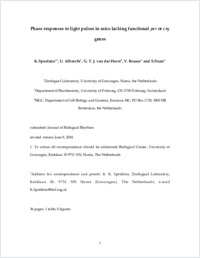Phase Responses to Light Pulses in Mice Lacking Functional per or cry Genes
- Spoelstra, Kamiel Zoological Laboratory, University of Groningen
- Albrecht, Urs Biochemistry Unit, Medicine Department, University of Fribourg, Switzerland
- Horst, Gijsbertus T. J. van der MGC, Department of Cell Biology and Genetics, Rotterdam, the Netherlands
- Brauer, Verena Zoological Laboratory, University of Groningen, Haren, the Netherlands
- Daan, Serge Zoological Laboratory, University of Groningen, Haren, the Netherlands
-
2004
Published in:
- Journal of Biological Rhythms. - 2004, vol. 19 (6), p. 518-529
English
The phase-resetting properties of the circadian system in mice with a functional deletion in mCry1, mCry2, mPer1, or mPer2 were studied in 2 experiments. In experiment 1, mCry1-/- and mCry2-/- mice as well as mPer1Brdm1 and mPer2Brdm1 mutant mice were exposed to 15-min light pulses during the 1st cycle following entrainment, either early (external time [ExT] 20) or late (ExT 4) in the subjective night. In experiment 2, a full PRC was measured for all these strains by exposure to light pulses of the same duration and intensity in free-running conditions in constant darkness. Directly after entrainment (experiment 1), mPer1Brdm1 animals did not show significant phase advances by a light pulse in the late subjective night (ExT 4), as in the study by Albrecht et al. In the same experiment, mPer2Brdm1 mice became arrhythmic too frequently to reliably measure their phase responses. Mice with a targeted gene disruption in mCry1 or mCry2 showed increased phase delays compared to wild type after exposure to a light pulse in the early subjective night (ExT 20). Otherwise, phase shifts were not significantly affected. In free run (experiment 2), all genotypes did show phase advances and phase delays. The mPer2Brdm1 mutant PRC was above the mPer1Brdm1 mutant and wild-type PRC (i.e., less delayed and more advanced) at most circadian phases. The mPer1Brdm1 mutant PRC was not distinguishable from the wildtype PRC. The mCry2-/- mice showed much smaller phase delays than did mCry1-/- mice in the subjective evening (delay phase). In general, mPer2Brdm1 mutant mice were more accelerated by light compared to mPer1Brdm1 and wildtype control mice, whereas mCry1-/- mice were more delayed by light than were mCry2-/- mice.
- Faculty
- Faculté des sciences et de médecine
- Department
- Département de Biologie
- Language
-
- English
- Classification
- Biological sciences
- License
-
License undefined
- Identifiers
-
- RERO DOC 4326
- DOI 10.1177/0748730404268122
- Persistent URL
- https://folia.unifr.ch/unifr/documents/299700
Statistics
Document views: 177
File downloads:
- Texte intégral: 358
